Kaus Borealis, Lambda Sagittarii (λ Sgr), is an orange giant or subgiant star located in the constellation Sagittarius. With an apparent magnitude of 2.82, it is the fifth brightest star in Sagittarius, after Kaus Australis, Nunki, Ascella, and Kaus Media. Kaus Borealis lies at a distance of 78.2 light years from Earth. It marks the northern tip of the celestial Archer’s bow and is one of the bright stars that form the Teapot, a conspicuous asterism that dominates the constellation.
Star type
Kaus Borealis has the stellar classification of K0 IV or K1IIIb, indicating a subgiant or giant star appearing orange in colour. It has a mass 2.6 times that of the Sun and is about 52 times more luminous. Its outer envelope has an effective temperature of 4,770 K.
Lambda Sagittarii has an angular diameter of 4.24 ± 0.05 milliarcseconds, which translates into a physical radius 11 times that of the Sun. The star is a relatively slow spinner, with a projected rotational velocity of 3.81 kilometres per second.
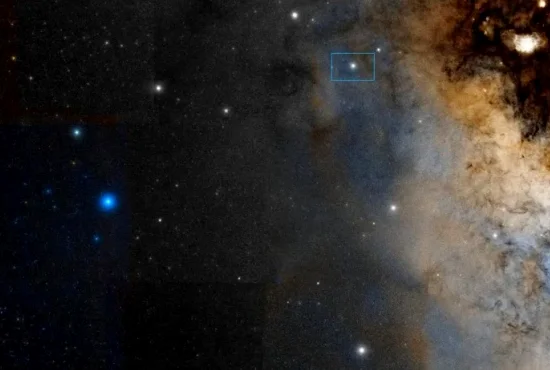
Kaus Borealis (Lambda Sagittarii), image: Wikisky
Facts
Kaus Borealis forms the Teapot in Sagittarius with the brighter Kaus Australis (Epsilon Sagittarii), Kaus Media (Delta Sagittarii), Nunki (Sigma Sagittarii) and Ascella (Zeta Sagittarii), and the fainter Alnasl (Gamma2 Sagittarii), Tau Sagittarii and Phi Sagittarii. Kaus Borealis marks the top of the lid of the celestial Teapot.
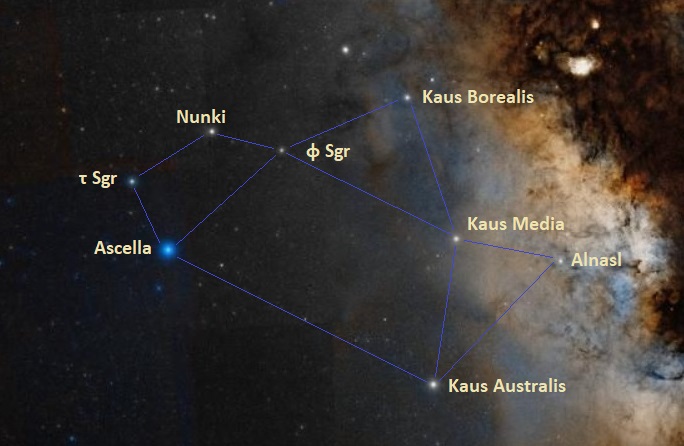
The Teapot in Sagittarius, image: Wikisky
The star is also part of a smaller asterism, the Little Milk Dipper, also formed by the Teapot stars Nunki, Ascella, Phi and Tau Sagittarii.
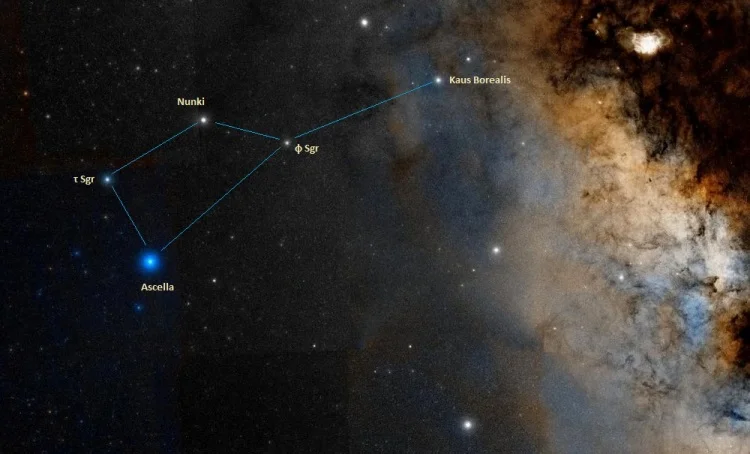
Little Milk Dipper, image: Wikisky
Like many other bright stars in zodiac constellations, Kaus Borealis lies close to the ecliptic (the Sun’s apparent path across the sky). It is located only 2.1 degrees south of the ecliptic and can sometimes be occulted by the Moon. Occultations by planets are also possible, but very rare. The last recorded occultation by a planet (Venus) occurred on November 19, 1984. Before that, the star was occulted by Mercury on December 5, 1865.
The 17th century Egyptian astronomer Al Achsasi al Mouakket called Lambda Sagittarii Rai al Naaim, meaning “the keeper of the ostriches,” in his Calendarium. The name was translated into Latin as Pastor Struthionum.
The 16th-century Arabian astronomer Al Tizini also called Kaus Borealis Rāʽi al Naʽāïm. In Arabic astronomy, Kaus Borealis and Polis (Mu Sagittarii) were seen as keepers of two groups of ostriches represented by two asterisms, Al Naʽām al Wārid (“the going ostriches”) and Al Naʽām al Ṣādirah (“the returning ostriches”). The asterisms were formed by the brightest stars in Sagittarius.
Name
The name Kaus Borealis (pronunciation: /ˈkɔːs bɒriˈælɪs/) means “the northern bow.” It is derived from the Arabic qaws, meaning “bow,” and the Latin borealis, meaning “northern.” The name refers to the star’s position in Sagittarius, marking the northern tip of the Archer’s bow. Kaus Australis marks the southern tip and Kaus Media, the midpoint of the bow. The name was officially approved by the International Astronomical Union’s (IAU) Working Group on Star Names (WGSN) on July 20, 2016.
The Chinese name for Lambda Sagittarii is 斗宿二 (Dǒu Sù èr), the Second Star of Dipper. The Chinese Dipper asterism also consists of the stars Nunki (Sigma Sgr), Ascella (Zeta Sgr), Polis (Mu Sgr), Phi Sagittarii, and Tau Sagittarii. It is one of the seven mansions of the Black Tortoise.
Location
Kaus Borealis is very easy to find because it belongs to a prominent southern asterism. The Teapot is visible to northern observers in the summer months, when it appears above the southern horizon in the evening. Kaus Borealis is the top star of the asterism.
The star can be used to find several bright clusters that lie in the vicinity. The Sagittarius Cluster (Messier 22) is located only 2.5 degrees northeast of the star. M22 is a globular cluster with an apparent magnitude of 5.5. At a distance of 10,600 light years from Earth, it is one of the nearest globular clusters to the Sun, as well as the brightest cluster of its kind that can be seen from mid-northern latitudes.
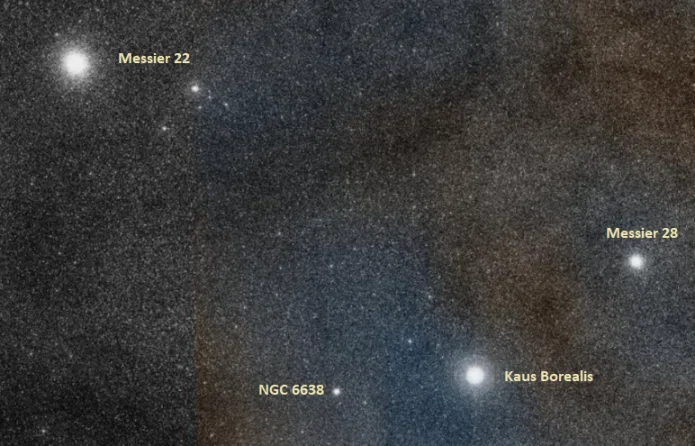
Kaus Borealis, Messier 22, Messier 28 and NGC 6638, image: Wikisky
Messier 28, another bright (mag. 7.66) globular cluster, is located less than a degree northwest of the star. It lies at a distance of 17,900 light years.
The globular cluster NGC 6638 is located only a half of a degree east of the star. At magnitude 9.5, it is considerably fainter than the other two clusters, as well as more distant. It lies about 30,600 light years from the Sun.
The magnitude 4.6 open cluster Messier 25 can be found 6.5 degrees north-northeast of the star, while the Sagittarius Star Cloud (Messier 24) lies about 7 degrees north-northwest. The open cluster Messier 18 can be found about 8.5 degrees in the same direction.
Constellation
Kaus Borealis is located in the constellation Sagittarius. Sagittarius is one of the Greek constellations, first listed by the Greco-Roman astronomer Ptolemy in the 2nd century CE. It is the 15th largest constellation in the sky and, due to its proximity to a rich field of the Milky Way, it contains more Messier objects (bright deep sky objects catalogued by the French astronomer and comet hunter Charles Messier) than any other constellation.
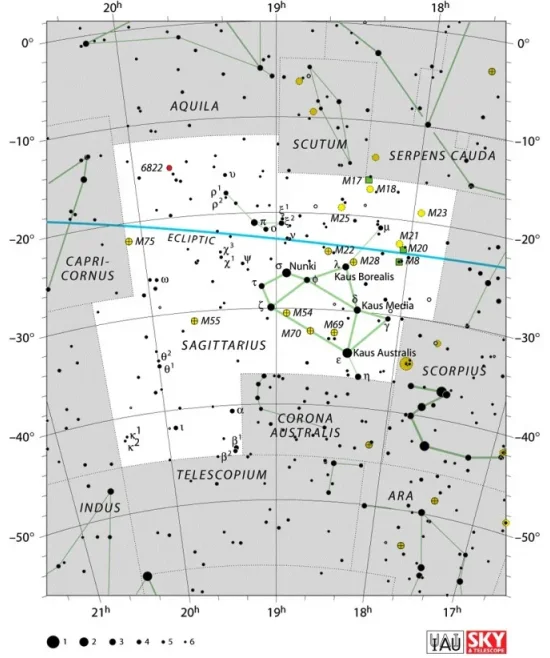
Sagittarius constellation map by IAU and Sky&Telescope magazine
In addition to those already mentioned, these include the Lagoon Nebula (Messier 8), the Omega Nebula (Messier 17), the Trifid Nebula (Messier 20), the globular clusters Messier 54, Messier 55, Messier 69, Messier 70 and Messier 75, and the open clusters Messier 21 and Messier 23.
Other notable deep sky objects in the constellation include the planetary nebulae NGC 6537, also known as the Red Spider Nebula, NGC 6818 (the Little Gem Nebula), and NGC 6445 (the Box Nebula), the star-forming region NGC 6559, and the open clusters known as the Arches Cluster and the Quintuplet Cluster, both home to some of the most massive and most luminous stars discovered to date.
Sagittarius also contains the centre of the Milky Way, marked by the radio source designated as Sagittarius A.
The best time of year to observe the stars and deep sky objects in the constellation is during the month of August, when Sagittarius is prominent in the evening sky.
The 10 brightest stars in Sagittarius are Kaus Australis (Epsilon Sgr, mag. 1.85), Nunki (Sigma Sgr, mag. 2.05), Ascella (Zeta Sgr, mag. 2.59), Kaus Media (Delta Sgr, mag. 2.70), Kaus Borealis (Lambda Sgr, mag. 2.82), Albaldah (Pi Sgr, mag. 2.89), Alnasl (Gamma² Sgr, mag. 2.98), Eta Sagittarii (mag. 3.11), Phi Sagittarii (mag. 3.17), and Tau Sagittarii (mag. 3.326).
Kaus Borealis – Lambda Sagittarii
| Spectral class | K0 IV or K1IIIb |
| U-B colour index | +0.903 |
| B-V colour index | +1.045 |
| Apparent magnitude | 2.82 |
| Absolute magnitude | 1.07 ± 0.008 |
| Distance | 78.2 ± 0.3 light years (23.97 ± 0.09 parsecs) |
| Parallax | 41.72 ± 0.16 mas |
| Radial velocity | –43.5 km/s |
| Proper motion | RA: −44.76 mas/yr |
| Dec.: −185.66 mas/yr | |
| Mass | 2.6 M☉ |
| Luminosity | 52 L☉ |
| Radius | 11 R☉ |
| Temperature | 4,770 K |
| Metallicity | -0.20 dex |
| Rotational velocity | 3.81 km/s |
| Surface gravity | 2.90 cgs |
| Constellation | Sagittarius |
| Right ascension | 18h 27m 58.24072s |
| Declination | −25° 25′ 18.1146″ |
| Designations | Kaus Borealis, Lambda Sagittarii, λ Sgr, 22 Sagittarii, HD 169916, HR 6913, HIP 90496, GC 25180, GCRV 10927, SAO 186841, PPM 268438, FK5 692, CD-25 13149, CPD-25 6523, GJ 713.1, GJ 9627, IRAS 18248-2527, 2MASS J18275824-2525175, WDS J18280-2525A, TYC 6861-3180-1, Gaia DR2 4076915349748285952 |